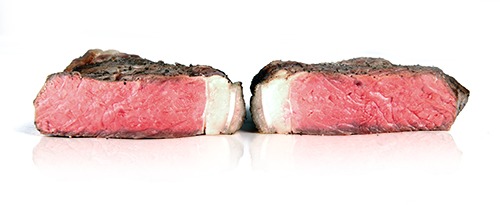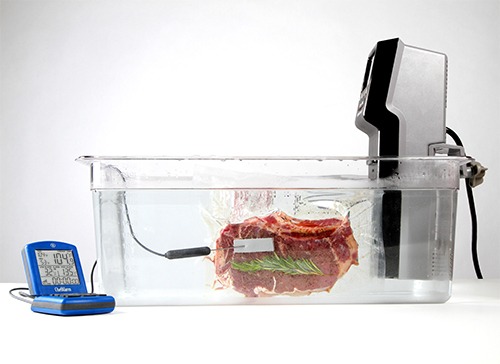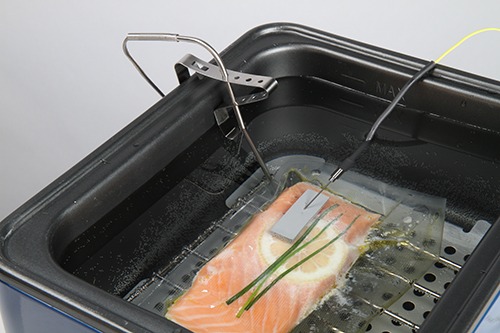An introductory guide to sous vide cooking
In his book, Cooking for Geeks, Jeff Potter calls sous vide, “…one of the biggest culinary revolutions to hit the commercial cooking scene in the past few decades…”
Sous vide (pronounced SOO-VEED) translated means “under vacuum.” Michael Chu, author at CookingforEngineers.com says, “…it is rumored that the origins of sous vide cooking in restaurants began in France during the 1970’s where George Pralus pursued this technique as a way to reduce product loss when preparing foie gras.” Chu says food cooked using the sous vide method loses less than 20% of its weight, while food cooked using the more traditional methods (e.g. frying, roasting, grilling) typically results in a 30% reduction in weight. The reduction in product loss comes as a result of the method in which the food being cooked is packaged (under vacuum), and the lower cooking temperatures. The result is a significant reduction in water and fat loss.
“At it’s simplest,” Potter says, “sous vide cooking is about immersing a food item into a precisely temperature-controlled water bath, where the temperature is the same as the target temperature of the food being cooked…Since the temperature of the water bath isn’t hotter than the final target temperature, the food can’t overcook.” “Sous vide cooking,” he says, “essentially locks the variable of temperature in the ‘time/temperature’ formula.”
Is it really revolutionary? Consider this, Food Scientist, and author of the Modernist Cuisine collection, Nathan Myhrvold, says, “The sous vide method yields results that are nearly impossible to achieve by traditional means.”
[Tweet “Nathan Myhrvold, says, “The sous vide method yields results that are nearly impossible to achieve by traditional means.””]
Advantages of Cooking Sous Vide
The industry leader in immersion circulators, and ThermoWorks’ counterpart in sous vide, PolyScience, says, “This [sous vide] technique eliminates all stress, time crunch and worries of overcooking…”
Sous vide cooking allows an inexperienced home cook to prepare (perhaps of the first time, ever) a perfectly cooked medium-rare steak. All it takes is a little understanding of chef recommended doneness temperatures.
Myhrvold says, “Precise temperature control and uniformity of temperature has two other big advantages. First, it allows you to cook food to an even doneness all the way through; no more dry edges and rare centers. Second, you get highly repeatable results. The steak emerges from the bag juicy and pink every time.”
Time is another advantage to sous vide. Some may look at the increased time as a disadvantage, after all, a medium-rare steak (done in 10 minutes on a range) can take as much as an hour and a half when cooking sous vide. “But,” Chu says, “the type of time it uses can be seen as an advantage.”
For most of the cooking, the home cook is not actively engaged. In fact, it’s possible to leave the food in the water bath for hours while you attend to errands and other daily chores. The laws of thermal physics make it impossible for your food to overcook should you leave it in the bath for too long. As Potter says, “…since the temperature of the water bath isn’t hotter than the final target temperature, the food can’t overcook.”
This juxtaposes traditional cooking where, Myhrvold says, “…there is little margin for error.” “With just a moments inattention,” he says, “conventional cooking can quickly overshoot perfection.”

This is especially useful when cooking meats and seafood, “…for which,” Myhrvold says, “the window of proper doneness is often vanishingly small when traditional methods are used. When you fry a piece of fish, the flesh is most succulent and tender within a very narrow temperature range. Because the cooking temperature of the pan is at least 392°F (200°C) hotter than the ideal core temperature of the fish, the edges will inevitably be far more cooked than the center when pan-fried.”
How do you do it?
“…the defining feature of the sous vide method is not packaging or vacuum sealing, it is accurate temperature control.” – Nathan Myhrvold
Recent advancements in immersion circulation technology, have taken sous vide cooking out of commercial kitchens and made it available for home use. High-end circulators, like those from PolyScience have found their way into the kitchens of serious home cooks, while less expensive models like those from Anova One, which happens to be an America’s Test Kitchen favorite priced at only $199.00, have brought sous vide into the mainstream.
Circulators allow you heat your water to a precise temperature and keep it there for an extended period of time. The Sous Vide Professional from PolyScience boasts a ±0.13°F accuracy. Less expensive models, like the America’s Test Kitchen Winner, Anova One, maintain water temps to within ±0.2°F.
[Tweet ““…the defining feature of the sous vide method is not packaging or vacuum sealing, it is accurate temperature control.” – Nathan Myhrvold”]
If you don’t have a circulator, it’s still possible to cook using the sous vide method. Alexis Ainouz, the face of “The French Guy Cooking,” shows us how to uniformly cook a steak with nothing more than a zipper storage bag, thermometer, beer cooler, and a lot of guts. Just remember what Myhvold says, “…sous vide is not packaging or vacuum sealing, it is accurate temperature control.” As long as you control the temperature of the water, you can create perfect results – every time.
If you’re adventurous enough to try the beer cooler method, arm yourself with a few fast and accurate thermometers. The ChefAlarm is ideal for monitoring the temperature of your water as your food cooks. Insert the probe into the water bath and set the low alarm to sound when you’ve breached your low temperature threshold.
If you’re cooking a steak medium-rare, the temperature of your water should hover somewhere between 130-140°F. You may suggest that 140°F is high for medium rare, but keep in mind over the course of one to one and a half hours of cook time your water will cool. Starting at 140°F will allow your water the ability to settle between 130 – 135°F (perfect medium rare).
If you’re working with a second thermometer (or a meter with two probes), insert the probe into the vacuum bag, or zipper storage bag with the aide of foam tape. This will keep the punctured bag from taking in water. Set your alarm to sound when you’ve reached your target temp and you’re all set.
Also keep in mind that carry over cooking is a non factor when cooking sous vide. Thermal equilibrium will not allow the food you’re cooking to get any hotter than the water it’s being cooked in. This again reaffirms Potter’s claim that, “the food can’t overcook!” (exclamation point added for emphasis!)
Potter sums up sous vide perfectly when he says, “…this cooking technique sounds foreign…” “But,” he says, “While foreign in origin, it is certainly not complicated or mysterious.” All that’s required are precise temperatures.




Great article!! Appreciate the information. Well done.
Love the foam tape hack! Now you’ve “enabled” me to justify a needle probe for my ThermaQ.
That’s great. You mention everything except flavor. My grilled and seared steak will taste must better than your vacuum sealed water bath steak.
Nicholas – We have a follow-up post coming where we’ll tackle what do do after the steak, fish, etc. comes out of the water bath. You’ll want to sear the outer layer to produce a crispy, flavorful crust.
I just bought a Anova One Precision Cooker and made my first sous vide Ribeye steak yesterday for steak and eggs. FANTASTIC. I have never tasted a steak like the one I cooked yesterday. I had purchased a prime grade of Ribeye steak and I wanted to cook it to my exact doneness. I’m also aware of the nice crust and flavor you get when grilling a good steak, but seriously, I never have tasted a steak like I did yesterday. I’ve read that when the steak hits the correct temperature, you can remove it from the bag and dry the steak with paper towels to subsequently sear the steak on a cast-iron pan for an effective Maillard reaction. I was crunched for time so I skipped the sear in the pan and just served the steak sliced for steak and eggs. I’m hooked on my sous vide cooking.
I used to think the same way, except that the sous vide steak cooks in its marinade/rub etc. then is on the grill to finish for seconds.
Much more flavor.
You need to go on beyond the sous vide. The steak coming out of the water bath at 120-130 is pale and naked looking. I used the cooler method a couple times and then bought a cheap circulator on eBay. It takes a minute or so in a hot skillet to add some crust and allow you to serve it hot with a little butter. I suppose fish would need the same attention. Hope you have a follow on soon.
Rookie – You’re absolutely right! And, we DO have a follow-up coming soon.
Following up sous-vide cooking a steak by searing on a skillet can certainly be done, but for me wasn’t necessary. I couldn’t believe the flavor of my steak without searing. Sure, you’ll get a Maillard reaction by searing, but I was lazy and didn’t want to sear. I certainly disagree with fish. I made a salmon that was phenomenal without a sear. It had great texture and taste without searing. For me, my wife and kids it tasted great.
Sounds great but how do you get a steak seasoned properly and the top and bottom browned and brazed to get the normal steak taste
Great question, and something we’ll be sure to tackle in a future blog post. Seasonings can be added to the meat before it’s vacuumed sealed. Not the rosemary with the steak and the lemon and chives with the salmon in the vacuum packs – in the photos. After your food is cooked, you can sear it in a hot pan, or if you’re super serious, take a blow torch to the surface of the food and get the Maillard reactions started. That will crisp up the outer layer and make it savory and delicious.
It is not true that you cannot overcook food using sous vide. You cannot overheat food, yes, but cooking is a function of temperature and time. For example, I have cooked cod sous vide at the same temperature, but for different times. In both cases the fish equilibrated to the bath temp. The shorter time resulted in fish with a proper texture and was pleasing to eat. The longer time caused the flesh to become mushy in texture and it was not pleasing to eat. This may not be as apparent for a steak, but it is misleading to suggest that you cannot overcook food using sous vide. Another way to think about it is how does pasteurization work? It can be accomplished with higher temperatures in less time or at lower temperatures for a longer time (see Douglas Baldwin’s white paper.) At the lower temperature, enzymatic reactions are sped up relative to body temperature, proteins slowly denature, eventually the bacteria die. It just takes longer at lower temperature. The same reactions are happening in meat–changes are happening as a function of time once the meat equilibrates to the bath temp. A primary effect is on texture. The 24 hour short rib reaches bath temperature in a few hours, but it is by no means “done”. Time is needed to break down the structural proteins that ultimately result in a tender product. A one week short rib would probably not be very pleasing to eat.
It seems that there is something important that has been left out of this article. This method never raises the temperature of the exposed outside surfaces which bare the potential for the presence of bacterial contamination, to a temperature high enough to kill the bacteria. I would hope that there is a final step on the bbq or grill that will kill any external bacteria.
@Gary G.
There are a of couple options. First is use a quality product where the meat is intact. No ground meat. No tenderizing by penetration. This minimizes risk of surface bacteria and the inside of meat is generally considered bacteria-free. A strong brine followed by a rinse will also reduce surface bacteria. Aesthetically, searing following cooking is desirable for many meats and will reduce surface bacteria. Some people even sear prior to sous vide.
Another approach is to refer to the pasteurization tables in Appendix C of this white paper:
It is possible to essentially sterilize food using the appropriate time@temperature conditions. Rapid chilling in an ice bath following pasteurization will result in a product that is safe for weeks if kept very cold (not freezing.) Airlines have been doing this for years.
Your sous vide steak recipe is absolutely mouthwatering! The precision of the cooking method really brings out the perfect tenderness and juiciness in the meat. I love how your recipe highlights the natural flavors of the steak while adding just the right amount of seasoning. Can’t wait to give it a try!